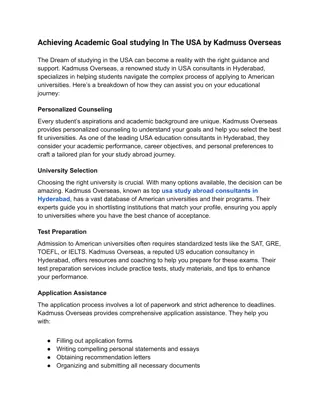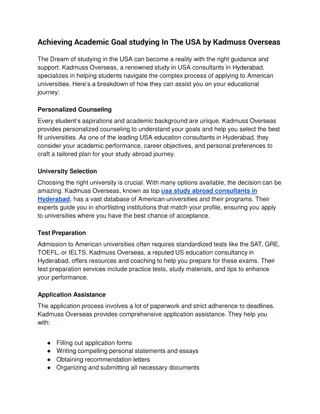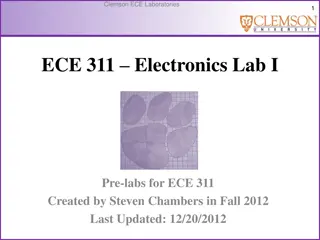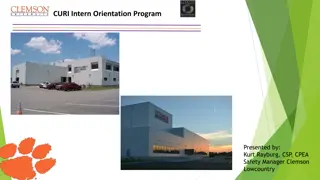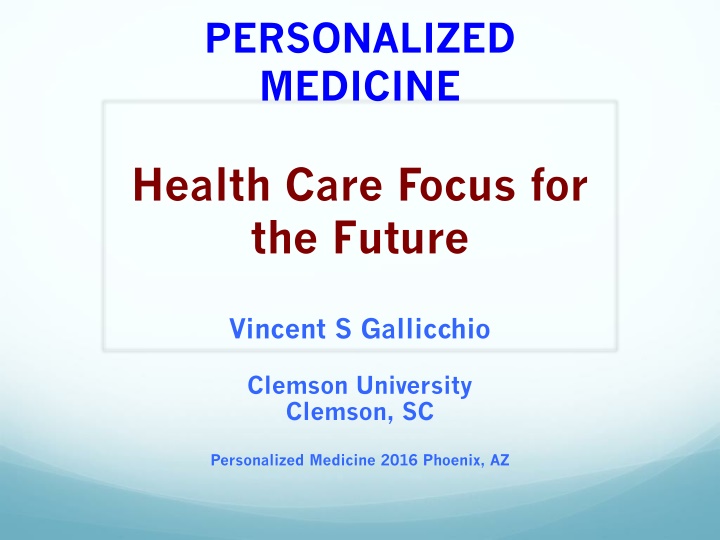
Customizing Health Care: The Future of Personalized Medicine
Discover the world of personalized medicine and its impact on health care delivery through molecular analysis. Understand how genetic profiles influence diagnostics and targeted therapies, optimizing treatment outcomes. Explore the background, methods, and experts driving this innovative approach.
Download Presentation

Please find below an Image/Link to download the presentation.
The content on the website is provided AS IS for your information and personal use only. It may not be sold, licensed, or shared on other websites without obtaining consent from the author. If you encounter any issues during the download, it is possible that the publisher has removed the file from their server.
You are allowed to download the files provided on this website for personal or commercial use, subject to the condition that they are used lawfully. All files are the property of their respective owners.
The content on the website is provided AS IS for your information and personal use only. It may not be sold, licensed, or shared on other websites without obtaining consent from the author.
E N D
Presentation Transcript
PERSONALIZED MEDICINE Health Care Focus for the Future Vincent S Gallicchio Clemson University Clemson, SC Personalized Medicine 2016 Phoenix, AZ
Personalized Medicine Medical model to customize delivery of health care through molecular analysis For the patient PM means targeted medical decisions, practices & therapies For diagnostic purposes patient s genetic profile will dictate diagnostic procedures & appropriate & targeted therapies Use of genetic information to better target drug therapies pharmacogenomics
PM - Background Everyone possesses unique variation of human genome Most individual variation has little effect on human health, however when combined with environmental factors can influence health status One aspect biological variation effects on response to medications, e.g., ADHD (effective in only 1 in 10 children); Cancer (25% patients) & Depression (6 in 10 patients)
Guy Haskin Fernald, Emidio Capriotti, Roxana Daneshjou, Konrad J. Karczewski and Russ B. Altman - http://www.ncbi.nlm.nih.gov/pmc/articles/PMC3117361/
PM - Background PM relies on technology to confirm patient s biology through analysis of DNA, RNA & protein Use of analytic approaches confirms patient diagnosis PM technique of genomic analytic analysis such as gene sequencing identifies mutations in DNA in order to aid specific diagnosis of diseases such as cancer and cystic fibrosis Another method RNA sequencing details specific RNAs in diseases Methods lead to improve understanding of patient s diagnosis & condition
PM - Methods Individual genome sequencing is not difficult to obtain yet essential to PM Body fluids such as blood or saliva can be used along with tissues. Material sent to a laboratory to isolate & sequence DNA Genomic sequencing technology is used to analyze all individual nucleotides Nucleotide sequencing is analyzed by high-speed computers to compute variations that indicate the presence of mutations are variations in sequencing linked to disease? Initially procedure was expensive, now more cost- effective to appeal to greater percentage of population
PM Mutation to Disease Important are mutations linked to disease? Study conducted Genome-wide association study (GWAS) GWAS focuses on a single disease, then analyzes genomic sequences of patients with the disease to determine the presence of shared mutations If shared mutation association identified, then search undiagnosed patients for the identical mutation to confirm disease diagnosis
PM Mutation to Disease In 2005 first GWAS performed in age-related macular degeneration (ARMD) Study found two-mutations, each only one nucleotide change called single nucleotide polymorphisms (SNPs) There have been more than 1,300 GWAS performed to date. They assist in identifying genetic variations associated with diseases
PM Disease Risk Assessment PM can be used to predict & assess disease risk for any patient, based upon single or several genes Allows physicians to assess whether a patient is at risk to develop a particular genetic disease, thus preventive measures can be initiated before disease symptoms appear Example, if genetic link to predispose patients to type II diabetes, then lifestyle changes can be initiated to reduce disease incidence
PM Advantages PM will change the way medicine is practiced One on-going issue in today s health delivery system is the lack of standards to define how medicine is practiced PM will be provide a more directed & unified treatment approach to individual patient & their genome PM offers to patients the hope of more accurate diagnoses with earlier intervention and more targeted therapies
PM Disease & Intervention PM - its focus on individual patients will allow for more accurate diagnosis & effective treatment strategy PM - will lead to genotyping using biological methods to analyze patient DNA PM - compares a patient s genomic DNA profile to a reference genome in order to determine if any genetic variations in the patient s genome increase their incidence of developing a specific disease PM private companies are now in business to provide individual genomic profiles directly to the public PM - knowing one s genomic profile can assist in targeting the most effective therapies to patients
PM Pharmacogenomics Use of individual s genome to provide more informed & tailored drug medications Drugs are developed with the assumption they work in a similar manner for all patients in the absence of patient variability Pharmacogenomics allows the design drugs that target specific genome expression, thereby providing more appropriate dosages & therapeutic outcomes in patients
PM Preventive Care PM has the potential to revolutionize preventive care In women, many are being genotyped for certain mutations, BCRA1 & BCRA2 especially if they have a family history of breast & ovarian cancer As more diseases are mapped based upon an ever increasing number of mutations in a genome, genetic induced diseases will become easier to predict & therefore use preventive measures It is expected accumulated databases in patient s genomics will improve treatment strategies for diseases such as Alzheimer s & cancer
PM Preventive Care PM will lead the development of companion diagnostics As drug experience in patients expands, the experience will be incorporated into future use in patients, thus allowing for enhanced therapeutic delivery for future patients based upon accumulated pharmacogenomic data
PM Drug Development Having an individual s genomic profile can be significant to develop individualized medications Genomic profiling will allow physicians to determine who would benefit from enrolling in any given clinical trial and who may not Benefits will include smaller numbers of enrolled patients in a trial, thus increasing the speed by which a trial could be conducted Reduce the chance of non-specific toxicity Shorter trials with less toxicity should reduce the overall cost of conducting clinical trials
PM Drug Development Drugs that would normally fail in a large scale clinical trial, might gain FDA approval if analyzed in patients with a known genomic profile Today s approach focuses on physicians conducting trial & error strategy until they find a therapy that s effective PM will allow therapies to be tailor made to patients based upon their genomic profile Physicians should be able to determine what therapies will work & what therapies will not based upon a patient s genome
PM Drug Development As the result of PM, patients will receive the most effective medicines, delivered at the most appropriate doses for the optimal period of time Example, Tamoxifen used to be prescribed for all ER+ breast cancer patients until it was discovered that in certain women with a mutation in their CYP2D6 gene were incapable of metabolizing the drug, thus making treatment ineffective Now with PM women can be genotyped to identify who will be the most effective responders to the drug
PM Cancer Genomics PM approach to cancer genomics Oncogenomics Application of PM to the treatment of cancer in order to optimize individual treatment High-throughput sequencing methods are used to assess genes related to cancer to better understand disease pathology & drug development Most promising area of genomics currently under investigation
PM Cancer Genomics Trastuzumab (Herceptin) is a monoclonal antibody that interferes with Her2/neu receptor. Used in breast cancer therapy if patients present with Her2/neu receptor overexpression Imatinib (Gleevac) is tyrokinase kinase inhibitor used in the treatment of CML where BCR-ABL genes are fused as a result of a reciprocal translocation between chromosome 9 & 22 present in 95% cases of CML. The drug blocks the action of ABL inhibitory protein
PM - Challenges Areas of concern: Intellectual Property Rights, Reimbursement Policies, Patient Privacy & Confidentiality & Regulatory Oversight These areas will need to be redefined as PM becomes more integrated into general medical practice Next generation sequencing will require computer- intensive data processing prior to its analysis Will require interdisciplinary cooperation between experts representing medicine, clinical oncology, biology & software engineering & public health agencies
Regulatory Oversight FDA has initiated incorporating PM in its regulatory policy guidelines October 2013 entitled, Paving the Way for Personalized Medicine: FDA s role in a New Era of Medical Product Development, outlined steps to be taken to integrate genetic & biomarker information for clinical use & drug development Develop specific regulatory science standards, research methods, reference material & other tools in order to incorporate PM into their current regulatory practices Working on a genomic reference library for regulatory agencies to compare & test the validity of different sequencing platforms in an effort to uphold reliability
Intellectual Property Rights Controversy regarding patent protection for diagnostic tools, genes & biomarkers. June 2013, U.S Supreme Court ruled natural occurring genes cannot be patented, while synthetic DNA that is edited or artificially- created can still be patented Patent Office is currently reviewing a number of issues related to patent laws for PM, such as whether confirmatory secondary genetic tests post initial diagnosis, can have full immunity from patent laws Those who oppose patents argue that patents on DNA sequences are an impediment to ongoing research while proponents agree that patents are necessary to protect the financial investments required for research & the development & advancement of services offered
Reimbursement Policies Reimbursement policies will have to be redefined to fit the changes that PM will bring to the healthcare system Factors that should be considered are (a) the level of efficacy of various genetic tests in the general population, (b) cost-effectiveness relative to benefits, (c) how to deal with payment systems for extremely rare conditions & (d) how to redefine the insurance concept of shared risk to incorporate the effect of the newer concept of individual risk factors
Patient Privacy & Confidentiality Most critical issue with the commercialization of PM is the protection of patients Major issue is the fear & potential consequences for patients who are predisposed after genetic testing or found to be non- responsive towards certain treatments. This includes psychological effects on patients due to genetic testing results Right of family members who do not directly consent is another issue, considering that genetic predispositions and risks are inheritable. The implications for certain ethnic groups and presence of a common allele would also have to be considered In 2008, the Genetic Information Nondiscrimination Act (GINA) was passed in an effort to minimize the fear of patients participating in genetic research by ensuring that their genetic information will not be misused by employers or insurers
Regenerative Medicine Regenerative medicine is a branch of translational research in tissue engineering and molecular biology which deals with the "process of replacing, engineering or regenerating human cells, tissues or organs to restore or establish normal function". Use of Stem Cells has and will continue to improve disease outcomes for an ever increasing cohort of patients with diagnoses that had been categorically identified with poor disease outcomes.
Regenerative Medicine Deals with the process of replacing, engineering or regenerating human translational research focused on regenerating human cells, tissues & organs to restore or establish normal function. process of replacing, engineering or regenerating human tissue. RM holds promise of engineering damaged tissues & organs by stimulating the body s own repair mechanisms to functionally heal previously irreparable organs. RM also includes possibility of growing tissues & organs in the laboratory & implanting them when the body cannot heal itself. If a regenerated organ's cells would be derived from the patient's own tissue or cells, this would potentially solve problem of the shortage of organs available for donation & problem of organ transplant rejection.
Summary PM will revolutionize health care delivery by providing more effective therapy targeted to an individual patient s condition PM should then provide more effective therapy while at the same time reduce overall health care costs by reducing length of hospitalizations & supportive care PM will continue to provide breakthroughs & discoveries in diagnostic clinical medicine
Thank You for Your Attention






